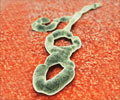The shape of the spike protein in Ebola virus, which is necessary for viral entry into human cells may have been uncovered by scientists at The Scripps Research Institute (TSRI).
The researchers say that their study revealed the Ebola virus spike protein bound to an immune system antibody acts to neutralize the virus.They say that their work is significant because it may help further scientists' understanding as to how the deadly virus works, which in turn may open the door for potential Ebola virus vaccines and treatments for those infected.
"Much about Ebola virus is still a mystery. However, this structure now reveals how this critical piece of the virus is assembled and, importantly, identifies vulnerable sites that we can exploit," Nature magazine quoted Erica Ollmann Saphire, the Scripps Research scientist who led the five-year effort, as saying.
Ebola hemorrhagic fever is presently incurable. People usually get infected with the virus when they come into contact with the bodily fluids of someone who is already infected.
Most sufferers eventually succumb to dehydration, massive bleeding, and shock.
The best treatment consists of administering fluids and taking protective measures to ensure containment, like isolating the patient and washing sheets with bleach.
Advertisement
The article says that the structure of the antibody together with the viral glycoprotein helps reveal the mechanisms by which the molecules assemble on the viral surface, and explain how the pathogen evades and exploits the human immune system.
Advertisement
Besides holding importance for Ebola, the researchers say, the new findings have significant implications for the study of viruses in general.
"Structures of the native, oligomeric forms of viral glycoproteins as they exist on the viral surface are exceedingly difficult to achieve and thus exceedingly rare. This structure now provides templates by which researchers studying other viruses could try to understand how their virus's surface protein is assembled and neutralized by an antibody," says Ollmann Saphire.
Source-ANI
RAS/K












